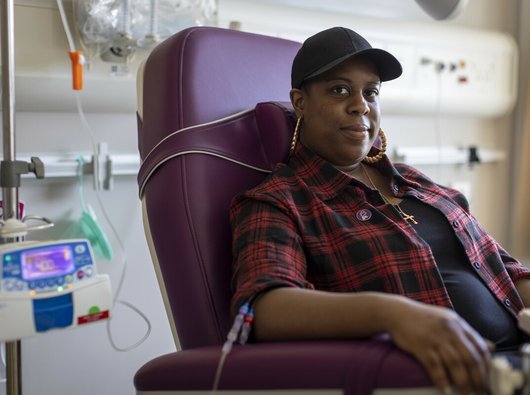Primary central nervous system lymphoma (PCNSL)
Primary central nervous system lymphoma (PCNSL) is a type of blood cancer that affects the brain, spinal cord or eyes (the central nervous system).
What is PCNSL?
Primary central nervous system lymphoma (PCNSL) is a type of blood cancer that affects the brain, spinal cord or eyes (the central nervous system).
PCNSL is a type of non-Hodgkin lymphoma. It affects white blood cells called B cells, causing them to grow out of control.
Other types of lymphoma can spread to the brain or spine from other areas of the body. This is called secondary CNS lymphoma. PCNSL starts in the central nervous system and does not affect the rest of the body.
PCNSL can affect parts of the eye. In this case, doctors count the eye as part of the central nervous system. Sometimes the eye is the only area affected by PCNSL.
In most cases, PCNSL is a variation of a more common blood cancer called diffuse large B-cell lymphoma (DLBCL). Because of where it starts, PCNSL affects the body differently, and is not treated in the same way as DLBCL.
The prognosis (what will happen in the future)
PCNSL is a fast growing blood cancer. Treatment usually starts within a few weeks of diagnosis.
Thanks to research, treatment for PCNSL has improved in recent years. Most people go into remission, where there are few or no lymphoma cells left, after treatment.
Your individual prognosis will depend on things that are personal to you, such as your age, your overall health and where the lymphoma is in your body. It also depends on how well the first treatment works, but there are more treatment options if it doesn’t work as well as hoped.
Being diagnosed with PCNSL
It’s always a shock to find out you have a type of cancer. As PCNSL is very rare, it can feel even more isolating.
It may help a little to know that you are part of a community of people with blood cancer who understand what you are going through.
If you would like to connect with some of them, visit our online community forum. You can also contact our Support Service to find out how we can help.

Symptoms of PCNSL
PCNSL can cause a wide range of symptoms, depending on where it grows. Common symptoms include:
- changes in behaviour or memory (forgetfulness, confusion, mood swings)
- trouble speaking or understanding
- weakness on one side of the body
- eye pain or problems with your eyesight
- headaches, feeling or being sick
- seizures (fits)
- depression or personality changes.
Tests to diagnose PCNSL
To get an accurate diagnosis, doctors will run a range of tests. You may have:
Scans
- an MRI scan of your brain and spine to check where the lymphoma cells are
- a PET-CT scan to check other areas of your body
- if you have testicles, an ultrasound to rule out testicular lymphoma.
Tissue or fluid tests
- a biopsy – a sample of tissue taken from your brain under anaesthetic, so you won’t feel anything
- a biopsy or sample of fluid taken from your eye, under anaesthetic
- a lumbar puncture (sometimes known as a spinal tap) to take a sample of spinal fluid. This is usually only done if a biopsy isn’t possible.
Tissue or fluid samples are sent to a lab to check for lymphoma cells. Doctors may also check for particular genetic changes that show you have lymphoma.
Blood tests
You may have blood tests to check how well your liver and kidneys are working and count the number of each type of blood cell in your blood (a full blood count).
We have more information on common tests for blood cancer, including scans.
Other tests
You may have a range of neurological tests to find out whether the lymphoma has affected your memory, thinking skills and movement. These tests may be repeated after treatment.
If you've just been diagnosed with PCNSL
Read our essential information for everyone who has just been diagnosed with blood cancer, whichever type it is.
You can also sign up for weekly support emails to find out what to expect and get tips and advice from others with blood cancer.

Treatment options
Your treatment will depend on your overall health and fitness, and how the lymphoma reacts to the first round. These are the main treatment options:
The brain is protected by something called the blood-brain barrier. This stops harmful substances getting into the brain, but can also stop standard lymphoma treatment getting to where it’s needed.
Methotrexate is a type of chemotherapy that can cross the blood-brain barrier. High-doses of methotrexate are often used as treatment for PCNSL, often along with other chemotherapy drugs and a targeted drug called rituximab.
One of the most commonly used combinations of drugs in PCNSL is called the MATRix regimen. The exact combination of drugs your doctor suggests for you will depend on your individual circumstances and the results of some tests.
After treatment with chemotherapy, some people have a stem cell transplant to help stop the lymphoma coming back. For PCNSL, you will usually have a transplant of your own healthy stem cells.
Stem cell transplant is a very strong treatment and it is not suitable for everyone. Your doctor will discuss whether this is an option for you.
Read more about stem cell transplants.
If a stem cell transplant isn’t possible, you may have radiotherapy to the whole of your brain. This can work well to kill any remaining lymphoma cells, but it can cause memory and other cognitive (thinking) problems.
If you are offered WBRT, ask your hospital team about the possible side effects. You can also call our Support Line on 0808 2080 888 to talk through the questions you might want to ask.
For less fit people
If your hospital team think that standard treatments will be hard for your body to cope with, you may be offered one or more of these treatments:
- less intensive chemotherapy
- lower dose radiotherapy
- steroids
- a combination of these.
These treatments aim to control the lymphoma and ease your symptoms.
For PCNSL in the eyes
If the lymphoma only affects the eyes and you are fit enough, you are likely to have the same treatment as for other types of PCNSL.
Less fit people may have chemotherapy injected directly into the eye – you’ll have drops to numb your eye, so this won’t hurt.
Clinical trials
You may be offered treatment through a clinical trial. A clinical trial will give you the best treatment currently available on the NHS, and the chance of a newer treatment that may be even better.
It's your choice whether you go on a clinical trial and you can withdraw at any time.
Find out more about clinical trials
Read our information explaining clinical trials, including the risks and the benefits. Our Clinical Trials Support Service can also talk to you about whether a clinical trial may be a good option for you.

Treatment side effects
Side effects are unwanted effects of treatment. They depend on the treatment you are having and vary from person to person – ask your hospital team what to look out for.
You won’t have all of the possible side effects and there are things you and your hospital team can do to help. Tell them if you notice anything new or different during your treatment.
We have more information on common side effects of blood cancer treatment.
Supportive care
Supportive care doesn’t aim to kill lymphoma cells but helps your body cope with your any symptoms and side effects. This could include medicine to protect you against infections.
Read more about your infection risk as someone with blood cancer.
What if the PCNSL comes back?
If PCNSL comes back (relapses), you may have the same combination of chemotherapy drugs, or a different combination, depending on how long it has been since your last treatment.
You may be offered a stem cell transplant or whole brain radiotherapy if you have not had it before.
There is lots of research happening to find new targeted treatments for PCNSL and other blood cancers. You may be offered one of these treatments through a clinical trial.
After Treatment
You are likely to have MRI scans during and after your treatment, to check what’s happened to the lymphoma. Your doctor might suggest follow-up scans every 3 to 4 months for the first 2 years after treatment. Ask your hospital team about your follow-up plan.
You may need assessment and support from other medical professionals, including:
- a neurologist or neuropsychologist for memory and other cognitive difficulties
- a physiotherapist for movement or co-ordination problems.
If treatment doesn’t clear the lymphoma, you may see a palliative care team. Palliative care aims to manage your symptoms and give you the best possible quality of life.
Living with PCNSL
A blood cancer diagnosis can affect your life in many ways: your mental health, your financial situation, the effect on your family and friends.
You may find it helpful to read our information on these topics:
- mind and emotions, including self-help tips and accessing counselling
- money, work and other practical advice
- guidance on eating well with blood cancer
- the benefits of keeping active
- information for family and friends.
Call our Support Line nurses free on 0808 2080 888 to talk through anything that’s worrying you or you’re not sure about.

Contact our support services team
Our team of nurses and trained staff offer support and information to anyone affected by or worried about blood cancer. Contact them by phone, email, or on our Community Forum.
More About ThisAbout this information
First published August 2025. Next full review due August 2028. We may make factual updates to the information between reviews.
We would like to thank Consultant Haematologist Dr Matthew Wilson for checking the clinical accuracy of this information.
We used generative AI to create an early draft of this information. It was then thoroughly checked and edited by a health information writer and approved by a clinical expert before publication.
Find out more about how we create our health information, including our approach to using AI.
